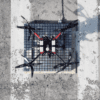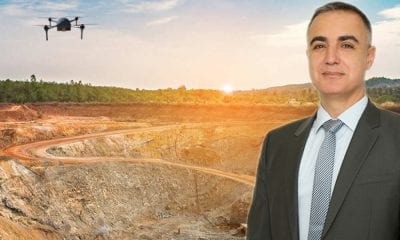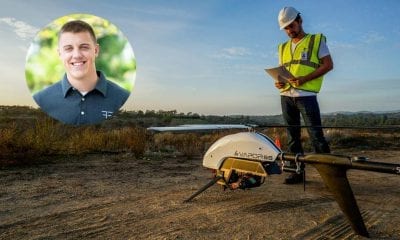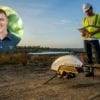Drone Delivery Innovation – Nathan Wrench, Cambridge Consultants
Cambridge Consultants are a product development and innovation company, helping clients worldwide achieve their ambitions through the creation, development or use of ground-breaking technology. They work in the medical, wireless, industrial and energy markets as well as commercial markets. Essentially, Cambridge Consultants are a group of over 700 world class engineers, physicists, scientists and designers operating from offices around the globe to solve clients’ problems and help them bring their new and innovative products to the market.
Can you tell us about the DelivAir project team, size, background?
Each year, we run a number of internal projects; these usually look to explore new markets, investigate interesting ideas, and keep our skills sharp. DelivAir started as one of these projects, and the initial project team was made up of a range of people at different stages in their career, from intern to company director. About 30 people have contributed their skills to the DelivAir project at some point in the project, with a ‘core team’ of perhaps five people.
Why the move into drone delivery for Cambridge Consultants?
Current methods for delivering goods in e-commerce suffer from efficiency problems – the last mile accounts for ~30% of the logistics cost, on average. That cost is also closely associated with the environmental burden of the logistics, from an emissions and congestion point of view. Moving the final mile delivery to very small, lightweight electric powered vehicles that can travel point-to-point avoiding traffic is a highly appealing idea, which is why it is gaining such attention.
We were discussing (over lunch, of course!) why drone delivery hasn’t really hit the mainstream yet. It has so much potential, but we don’t really see the current solutions as being really feasible or a big improvement over current delivery systems from a consumer’s viewpoint. They still need a delivery address, and you need to be at that address at the time of the delivery, otherwise your parcel is unceremoniously dumped in your garden. Really not ideal from a recipient’s perspective!
We decided that the solution to this was to deliver the parcel to the recipient, no matter where they are.
How long from the drawing board to 1st flight, and what were the challenges faced when developing DelivAir?
It took roughly 6 months to get the drone designed and an early prototype flying. From there, we took another 3 months developing the delivery to hand process and completing trials of fully automated flying. From the first lunch-time discussion it took about 8 months to get the first fully-automated delivery to hand completed.
The real challenges were integrating all the systems and getting them to talk to each other seamlessly. There’s so many different components to DelivAir, and the autonomous flight computer, computer vision system and winch all need to work perfectly to get the delivery right into the palm of your hand. Developing the vision system on a Raspberry Pi and a bespoke, lightweight winch were definitely two of the most challenging components.
You have patent pending, please tell us more?
Our system of delivering “to-the-hand” required a fair few novel ideas and components, both software and hardware, and they are covered by the patent.
What’s next beyond the prototype system you’ve developed?
Our prototype shows the kind of precision that’s possible with drones, and to introduce the concept to possible market sectors. Next steps would be develop a commercial system with a higher performance camera, higher powered computer and a bespoke drone capable of transition flight.
Beyond the operating flight platform though there are significant challenges to overcome in terms of the regulatory environment, flight path allocation and collision avoidance. These issues apply to the entire market place – not just to our concept.
Do you plan to license the technology or take the DelivAir system to market?
The purpose of the project was to reimagine drone delivery, and take it away from just being a quicker form of conventional delivery. An ideal next step would be to work with another company who is developing a delivery drone and wants to integrate our vision and winch systems, or a company wanting to use the DelivAir concept in their operations.
Can you share any details, specs on the actual drone, materials and software?
We used a DJI S1000 platform, with Pixhawk 2 flight computer. We used a Raspberry Pi and RPi camera in our vision system. The winch, mountings and parcel release mechanism were all bespoke and manufactured in-house.
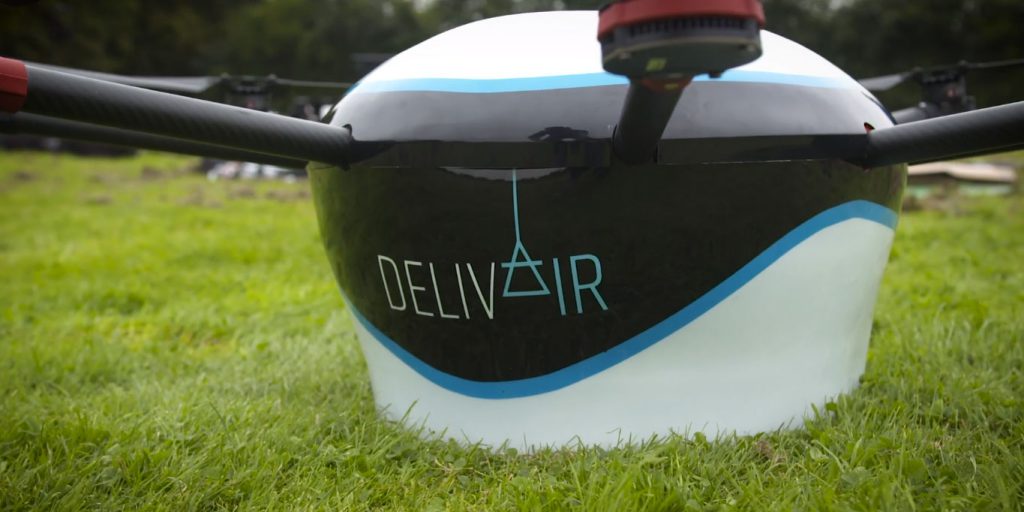
How do you deal with natural hazards, wind, rain, wildlife?
We can currently deal with reasonably windy conditions thanks to our adaptive vision system, which tracks the parcel location relative to the user. We anticipate that we will be able to make DelivAir suitably waterproof so delivery in light to medium rain should also be alright.
As for wildlife and other aerial obstacles, all drones intended for commercial use in the future will need to have object sense and avoidance protocols; our is no difference. This is certainly one of the big challenges facing the commercialisation of drones, but many companies have made great strides in overcoming it.
Are there or will there be any collaborative elements to the project?
Some of the systems we have used are off-the-shelf items, such as the platform and flight computer. In future iterations of DelivAir, we envisage that we’ll work closely with other companies, especially from an flight-autonomy and flight platform perspective.
Will you be exhibiting DelivAir?
We have exhibited DelivAir in a couple of Cambridge-based events, as well as at some leading universities. Hopefully we should be continuing to exhibit DelivAir next year!
Overall how do you see the drone technology expanding or changing in the next 5 years?
The main civilian use of drones is currently in aerial imagery, be that as part of the entertainment industry, agriculture, consumer toys, real estate or the various other markets where they have been found to add value. The operating requirements for single platforms taking aerial imagery are orders of magnitude less complex than what might be considered the more exciting uses such as internet service provision, delivering physical goods and transportation of people. Fundamentally, a widespread system of autonomous/ semi-autonomous aerial vehicles must be operated to a very high standard of reliability to ensure commercial feasibility. It would simply not commercially feasible to operate a fleet of air vehicles that had a chance of failure the same as is currently seen in even the best consumer/ prosumer camera drones. This is not just an engineering challenge but a logistics, legal, procedural and political challenge. In the next five years we anticipate the world will see a growing size of autonomous aerial vehicle system trials, but that they will remain trials within this time period
The next 20 years?
By 2037 we anticipate that autonomous aerial vehicles will be operating safely and delivering commercial value within our airspace. This may be an application that is not currently being investigated however, airborne pest control or window cleaning to name a few.
There’s lots of interesting stuff happening in the drone delivery systems market, who else is impressing you in this regard?
It isn’t immediately obvious whether the large players operations in this area are purely marketing exercises, technology speculation, serious endeavours or a mixture of all of these. Certainly some, like Alphabet Project Wing appear to have undergone a shift away from the hardware and operating the final service and instead have focused on the back end software necessary to automate a coordinated, reliable drone system potentially with many thousands of drones in the air at a time.
Anything else you’d like to add?
One of the keys to the eventual success of all technology, and drones are no exception, is abstracting the end user from the technical operation. The DelivAir concept embodies this, the recipient doesn’t get a drone delivery they get an air delivery hence “DelivAir.”
About Nathan Wrench at Cambridge Consultants.
 Global Head of the Industrial & Energy practice at Cambridge Consultants, working with some of the world’s most ambitious companies to transform their businesses through the development or application of breakthrough technology.
Global Head of the Industrial & Energy practice at Cambridge Consultants, working with some of the world’s most ambitious companies to transform their businesses through the development or application of breakthrough technology.
Interests include the development of novel robotics, sensing and control and Machine Learning solutions, applied to applications across market sectors including Retail & Logistics, Agri-Tech, Transport & Infrastructure and Energy.







